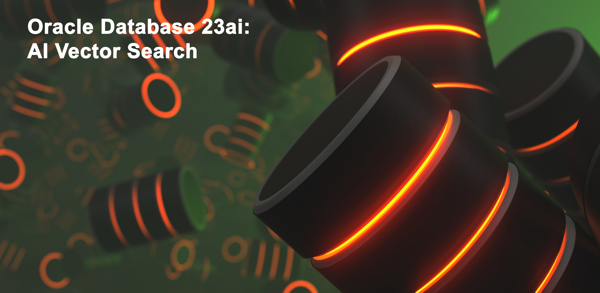Unlocking the Power of AI Vector Search in Oracle Database 23ai

Oracle has recently, May 2, 2024, unveiled Oracle Database 23ai, packed with innovative AI capabilities that are transforming the way businesses manage and analyze their data. Among these cutting-edge features is AI Vector Search, a game-changer for organizations seeking to unlock valuable insights from complex vector data.
Understanding Vector Data and its Challenges
Vector data, also known as feature vectors, is a representation of data in a high-dimensional space. Each data point is described by a set of numerical features, forming a vector. This type of data is commonly used in machine learning and artificial intelligence applications, such as image recognition, natural language processing, and recommendation systems.
One of the main challenges with vector data is the difficulty in performing similarity searches. Traditional database systems excel at querying structured data using exact matches or range queries, but they fall short when it comes to finding similar vectors based on their proximity in high-dimensional space. This is where Oracle’s AI Vector Search steps in.
Revolutionizing Vector Data Search with AI
AI Vector Search in Oracle Database 23ai introduces a paradigm shift in the way vector data is queried and analyzed. Here’s how it works:
1. Indexing Vector Data
Oracle Database 23ai allows users to index vector data, treating it as a first-class data type. This means that vector data can be efficiently stored, indexed, and queried just like any other data type in the database.
2. Similarity Searches
Oracle AI Vector Search enables users to perform similarity searches on vector data. Instead of looking for exact matches, this feature allows you to find vectors that are similar to a given query vector. It measures the proximity of vectors in high-dimensional space and returns the most similar results.
3. Fast and Scalable Searches
The power of Oracle AI Vector Search lies in its ability to perform these searches at lightning speed, even in large and high-dimensional vector spaces. Oracle has optimized the indexing and search algorithms to handle massive datasets efficiently, ensuring that similarity searches are fast and scalable.
4. Integration with Machine Learning
Oracle AI Vector Search is seamlessly integrated with Oracle’s in-database machine learning capabilities. This means that users can combine vector data with other types of data, apply machine learning algorithms, and build end-to-end AI applications directly within the database.
Use Cases
Oracle AI Vector Search opens up a world of possibilities for organizations across various industries:
1. Image and Video Search
With AI Vector Search, you can perform content-based image and video searches. For example, a media company can enable users to search for similar images or videos based on visual content, even if they don’t have specific keywords or metadata.
2. Recommendation Systems
Vector data is commonly used in recommendation systems to model user preferences. Oracle AI Vector Search can be leveraged to find similar users or items, enabling more accurate and personalized recommendations.
3. Natural Language Processing (NLP)
In natural language processing (NLP), vector representations of words and documents (word embeddings) can be used for semantic searches. AI Vector Search allows for finding documents similar in meaning to a given query, even if they don’t share the exact keywords.
Conclusion
Oracle Database 23ai’s AI Vector Search capability is a breakthrough for organizations seeking to harness the power of vector data. By providing efficient and scalable similarity searches, Oracle is revolutionizing the way businesses analyze and derive insights from complex data. With this feature, organizations can unlock the full potential of their AI and machine learning initiatives, driving innovation and gaining a competitive edge.
To explore more about Oracle Database 23ai and its AI capabilities, refer to the official Oracle blog: Oracle 23ai AI: Now Generally Available or contact RheoData @ [email protected]


